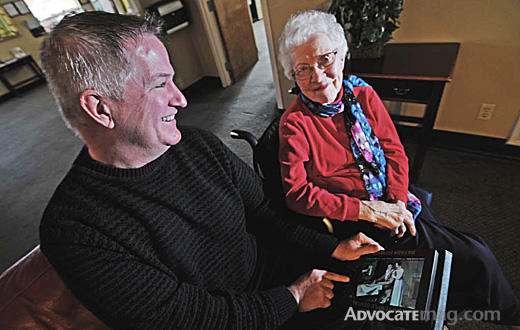MARK LOMBARD of Stevens Park figured out a way to bring the world’s greatest art to people who couldn’t otherwise see it. A hospice volunteer, Lombard founded For Love and Art: Sharing with Seniors, which uses digital photo albums to take people at the end of their lives to virtual museums, from the Meadows to the Met.
Where did the For Love and Art idea come from?
I really looked at my life and decided what was important to me. And I decided that it was great art. The DMA is like my second home. I’m a volunteer with Lion Hospice, and one of my clients is Miss Billie (who is pictured above). She was working on getting her legs stronger, and I said, ‘Get your strength up, and I’ll take you to the museum,’ and she would just light up. As it turned out, she never got to go to the museum, so I started bringing her postcards with pictures of artwork on them. I noticed that when she was in the presence of this art, she looked young again. I wanted to bring that experience to people in hospice. If they can’t come to museums, I’m going to bring art to them.
So how did you get it going?
I couldn’t get anyone excited about the idea. There was no structure to it. I sent emails to all the local museums, and finally I heard back from a woman at the Amon Carter Museum, and she invited me to come talk to them. After that I realized the digital photo book was the missing link. It’s relatively low cost. And it’s not a laptop. It’s not an iPad. It’s not something that’s likely to be stolen. It’s an easy, durable way for us to bring the art experience to those with limited mobility.
You have entire collections from the Met and the Smithsonian, among many others. How did you get permission to use images of these great works?
After we figured out the structure, museums started jumping on board. It turns out they wanted to reach the people we’re trying to reach. First we got Amon Carter on board, and then we got the DMA, the Modern, the Meadows. Then New York jumped on board, and that was a big surprise to me. The Met is in there. That’s pretty amazing. I have the Smithsonian in my hand. I have the Met in my hand.
Why did you think it was so important to bring art to people in hospice care?
The enjoyment of this is not an intellectual pursuit. It’s emotional. It’s visceral. That’s the power of art. If you look at it, it kind of takes you over. And you’re young again. You’re beautiful. This project is not to educate as much as to inspire and uplift.
Is the idea catching on now?
Yes. It’s not just patients; the staff loves it. The families love them. You know, people want to put the end of life out of their mind and sights. We want to change that attitude from abandon to embrace. We want to alter their thinking to want to spend time with these people at the end of their lives. So now we have about 30 art books out in the world — in New Jersey, Pennsylvania, Florida, Texas.
What are your plans next?
Once we show the world that we can deliver on what we do, then we’re going to hit the Louvre, the Tate, the National Gallery in London, the Prado. We’re going to head around the world.
How can people help?
We’re soliciting volunteers and donations. We’re a nonprofit organization. Each one of these [photo books] costs $400, and you can make a $50 donation. Or if you buy the whole thing, then you get a dedication. We have a waiting list of over 100 hospitals that really want this. We just have to raise the money.
Contact For Love and Art at forloveandart.org or 214.693.8941.






